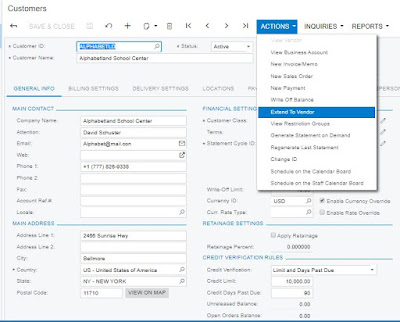Reconciliation of APhistory with GL
Reference:
The script:
SELECT
APHistorySum.CompanyID,
APHistorySum.FinPeriodID,
APHistorySum.AccountID,
APHistorySum.CustomerID,
APHistorySum.SubID,
APHistorySum.Turnover,
GLTransactionSum.TotalAmount,
(APHistorySum.Turnover <> GLTransactionSum.TotalAmt) AS DoesReconcile,
FROM
(
SELECT
CompanyID,
FinPeriodID,
AccountID,
CustomerID,
SubID,
Turnover = SUM(FinYtdBalance - FinBegBalance)
FROM APHistory
GROUP BY
CompanyID,
FinPeriodID,
AccountID,
SubID,
CustomerID) AS APHistory
LEFT JOIN (
SELECT
CompanyID,
FinPeriodID,
AccountID,
ReferenceID,
SubID,
TotalAmount = SUM(DebitAmt - CreditAmt)
FROM
GLTran
WHERE
Module = 'AP'
GROUP BY
CompanyID,
FinPeriodID,
AccountID,
SubID,
ReferenceID) AS GLTransactionSum
ON APHistorySum.CompanyID = GLTransactionSum.CompanyID
AND APHistorySum.FinPeriodID = GLTransactionSum.FinPeriodID
AND APHistorySum.AccountID = GLTransactionSum.AccountID
AND APHistorySum.CustomerID = GLTransactionSum.ReferenceID -- the vendor ID is stored in this field for AP-originated GL transactions
AND APHistorySum.SubID = GLTransactionSum.SubID
Here the error message from SQL:
Msg 102, Level 15, State 1, Line 9
Incorrect syntax near '<'.
Msg 156, Level 15, State 1, Line 25
Incorrect syntax near the keyword 'AS'.
Msg 156, Level 15, State 1, Line 43
Incorrect syntax near the keyword 'AS'.
What's wrong with the script?
I will highlight in blue the element of the script which generates the error.
- for APHistorySum.Turnover and GLTransactionSum.TotalAmt to reconcile, the sum should be Zero. Therefore it should be changed to (APHistorySum.Turnover + GLTransactionSum.TotalAmt ).
- There is no need for a comma (,)after DoesReconcile.
- We are in a Vendor context, so CustomerID is incorrect, should be VendorId.
- The APHistory alias should be APHistorysum.
The Solution
SELECT
APHistorySum.CompanyID,
APHistorySum.FinPeriodID,
APHistorySum.AccountID,
APHistorySum.VendorID,--change customerid to vendorid
APHistorySum.SubID,
APHistorySum.Turnover,
GLTransactionSum.TotalAmount,
(APHistorySum.Turnover + GLTransactionSum.TotalAmount) AS DoesReconcile--Change TotalAmt to TotalAmount and <> to +
FROM
(
SELECT
CompanyID,
FinPeriodID,
AccountID,
VendorID,
SubID,
Turnover = SUM(FinYtdBalance - FinBegBalance)
FROM APHistory
GROUP BY
CompanyID,
FinPeriodID,
AccountID,
SubID,
VendorID) AS APHistorySum--first error change from APHistory to APHistorySum
LEFT JOIN (
SELECT
CompanyID,
FinPeriodID,
AccountID,
ReferenceID,
SubID,
TotalAmount = SUM(DebitAmt - CreditAmt)
FROM
GLTran
WHERE
Module = 'AP'
GROUP BY
CompanyID,
FinPeriodID,
AccountID,
SubID,
ReferenceID) AS GLTransactionSum
ON APHistorySum.CompanyID = GLTransactionSum.CompanyID
AND APHistorySum.FinPeriodID = GLTransactionSum.FinPeriodID
AND APHistorySum.AccountID = GLTransactionSum.AccountID
AND APHistorySum.VendorID = GLTransactionSum.ReferenceID -- the vendor ID is stored in this field for AP-originated GL transactions
AND APHistorySum.SubID = GLTransactionSum.SubID
--We are in Vendor context so VendorID must be changed to VendorID
The result





